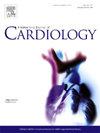通过全身电子肌肉刺激进行体育训练可对健康成年人的心血管生物标志物产生有利影响--随机对照试验。
IF 3.2
2区 医学
Q2 CARDIAC & CARDIOVASCULAR SYSTEMS
引用次数: 0
摘要
背景:体育锻炼可预防心血管疾病(CVD),并能有效改善心血管疾病的风险状况。然而,超过 25% 的美国成年人表示没有参加体育锻炼。全身电子肌肉刺激(WB-EMS)训练是美国食品药品管理局(FDA)批准的一种新型技术,它通过经皮电脉冲传输同时刺激主要肌肉群,为体育训练提供了一种省时、适应性强的方法。研究表明,久坐不动的人在接受 WB-EMS 训练后,肌肉质量增加、脂肪量减少、功能能力提高,但还缺乏评估 WB-EMS 训练对心血管疾病风险的作用的研究:我们在健康成年人中开展了一项试验性随机对照试验,研究人员随机接受了使用和不使用 WB-EMS 的体育训练,每周一次,每次 20 分钟,持续 16 周。研究参与者被要求进行日常活动,但在研究期间不得进行任何力量训练。在每次训练过程中,所有研究参与者都要穿上专门设计的背心,并用电线将手臂和腿部绑带与 WB-EMS 设备(德国格斯特霍芬,Miha Bodytec)连接起来。通过背心和绑带进行双相电刺激(4 秒钟开,4 秒钟关),刺激频率为:大腿、臀部、下背部、上背部、背阔肌、腹部、胸部和手臂时,参与者在博格感觉用力评分量表上获得 5 分或 6 分。这些频率在前 4 周进行 "滴定",然后固定为每个参与者的每个肌肉群。不接受 WB-EMS 的受试者佩戴相同的设备,但不接受电刺激。体能训练课程由获得 WB-EMS 训练认证的私人教练提供,包括固定数量的练习和重复练习。我们对基线和干预后的几个临床重要心血管参数进行了测量和比较:在 2021 年 1 月至 2022 年 3 月期间招募了 78 名参与者,平均年龄为(35.9 ± 11.2)岁,女性占 61.3%,中位体重指数为 24.3(21.8, 28.1);N = 46 人被随机分配到干预组,N = 32 人被随机分配到对照组。18名参与者(23%)退出了试验,其中9人退出了EMS组(19.6%),9人退出了对照组(28.1%)。WB-EMS组和对照组的退出率没有明显差异(P = 0.27)。与对照组相比,干预组的参与者在 16 周的训练后出现了以下变化:腰臀比(∆ -0.03 ± 0.05,p = 0.01 vs. -0.01 ± 0.0,p = 0.1)、外周血管内皮功能(使用反应性充血外周动脉测压法测量)(∆: 0.02 ± 0.1,p = 0.5 vs. -0.20 ± 0.3,p = 0.05)、高敏 C 反应蛋白(∆:0.06 ± 0.7,p = 0.3 vs. 0.20 ± 2.3,p = 0.02)、总胆固醇(∆:-1.7 ± 25.1,p = 0.3 vs. 19.2 ± 26.5,p健康成年人每周接受一次 WB-EMS 体育训练后,心血管风险的生物标志物要么得到改善,要么保持稳定,而只接受传统训练的人的心血管风险生物标志物要么保持稳定,要么恶化。因此,WB-EMS 可以提供一种有效、省时的体能训练方式,无法或不愿进行常规锻炼的人可以考虑使用。本文章由计算机程序翻译,如有差异,请以英文原文为准。
Physical training augmented with whole body electronic muscle stimulation favorably impacts cardiovascular biomarkers in healthy adults – A pilot randomized controlled trial
Background
Physical activity is protective against cardiovascular disease (CVD) and favorably improves CVD risk profile. However, more than 25 % of American adults report no participation in physical activity. Whole body electronic muscle stimulation (WB-EMS) training is a novel FDA-cleared technology which offers a time-efficient and adaptable method for physical training by simultaneously stimulating the main muscle groups using percutaneous electrical impulse transmission. Studies have demonstrated increased muscle mass, reduced fat mass, and improved functional capacity in sedentary individuals after training with WB-EMS, but studies evaluating the role of WB-EMS training on CVD risk profile are lacking.
Methods
We performed a pilot randomized controlled trial in healthy adults randomized to physical training with versus without WB-EMS for one session of 20 min duration per week across 16-weeks. Study participants were asked to perform their usual activities but to abstain from any strength training during the study. During each training session, all study participants wore a specifically designed vest and arm and leg straps that were connected with electrical wires to the WB-EMS device (Miha Bodytec Gersthofen, Germany). Biphasic electrical stimulation was delivered through the vest and straps (4 s on, 4 s off) at a frequency that elicited a score of 5 or 6 on the Borg rating of perceived exertion scale from study participants when each of the following muscle groups was stimulated: thighs, buttocks, lower back, upper back, latissimus dorsi, abdomen, chest and arms. These frequencies were ‘titrated’ during the first 4 weeks and were then fixed at each muscle group for each participant. Individuals randomized to no WB-EMS wore the same equipment but received no electrical stimulation. Physical training sessions were provided by personal trainers certified for WB-EMS training and consisted of a fixed number of exercises and repetitions. We measured and compared several clinically important cardiovascular parameters at baseline and post-intervention.
Results
Seventy-eight participants were recruited between January 2021 and March 2022 with a mean age of 35.9 ± 11.2, 61.3 % females, median BMI 24.3 (21.8, 28.1); N = 46 were randomized to intervention group and N = 32 were randomized to the control group. Eighteen (23 %) participants dropped out of the trial, including 9 participants from the EMS arm (19.6 %), and 9 participants in control arm (28.1 %). There was no significant differences in the rate of dropping out of the WB-EMS and control groups (p = 0.27). Those in the intervention group compared to controls exhibited the following changes after 16-weeks of training: waist:hip ratio (∆ -0.03 ± 0.05, p = 0.01 vs. -0.01 ± 0.0, p = 0.1), peripheral endothelial function, measured using reactive hyperemia peripheral arterial tonometry (∆: 0.02 ± 0.1, p = 0.5 vs. -0.20 ± 0.3 p = 0.05), high-sensitivity C-reactive protein (∆: 0.06 ± 0.7, p = 0.3 vs. 0.20 ± 2.3 p = 0.02), total cholesterol (∆: −1.7 ± 25.1, p = 0.3 vs. 19.2 ± 26.5, p < 0.001), high density lipoprotein (∆: 2.02 ± 6.6, p = 0.2 vs. 3.6 ± 7.5 p = 0.01) and low density lipoprotein cholesterol (∆: 0.5 ± 26.7, p = 0.4 vs. 17.1 ± 23.2, p < 0.001).
Conclusion
Once weekly physical training with WB-EMS in healthy adults resulted in either improved or stable biomarkers of cardiovascular risk, which either remained stable or worsened in those undergoing conventional training alone. Thus WB-EMS may provide an effective and time-efficient form of physical training that may be considered in those unable or unwilling to perform exercise conventionally.
求助全文
通过发布文献求助,成功后即可免费获取论文全文。
去求助
来源期刊

International journal of cardiology
医学-心血管系统
CiteScore
6.80
自引率
5.70%
发文量
758
审稿时长
44 days
期刊介绍:
The International Journal of Cardiology is devoted to cardiology in the broadest sense. Both basic research and clinical papers can be submitted. The journal serves the interest of both practicing clinicians and researchers.
In addition to original papers, we are launching a range of new manuscript types, including Consensus and Position Papers, Systematic Reviews, Meta-analyses, and Short communications. Case reports are no longer acceptable. Controversial techniques, issues on health policy and social medicine are discussed and serve as useful tools for encouraging debate.
 求助内容:
求助内容: 应助结果提醒方式:
应助结果提醒方式:


